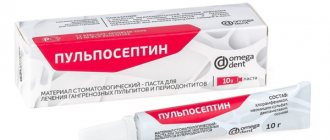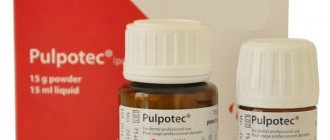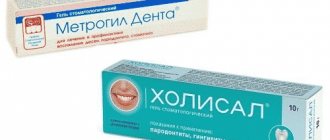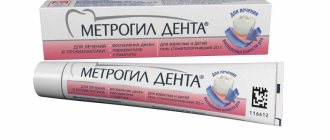Write a review
Reviews: 0
Manufacturers: Aventis Pharma (UK)
Active ingredients
- Artikain
- Epinephrine
Disease class
- Not indicated. See instructions
Clinical and pharmacological group
- Not indicated. See instructions
Pharmacological action
- Local anesthetic
Pharmacological group
- Local anesthetics in combinations
When is the best time to treat teeth during pregnancy?
Conventionally, the pregnancy period is divided into three periods - trimesters . The first trimester is characterized by the formation of all organs and systems; in the second trimester , their smooth development occurs; in the third trimester , their preparation for independent work or independent functioning occurs.
Each trimester has its own management features - the first and third have the largest number of “critical periods”, so any medical interventions are considered undesirable (of course, except for those that are necessary to preserve the life and health of the mother and baby). The second trimester (this is approximately 14-20 weeks) is the safest, including for dental treatment.
Dental treatment and lactation
Breastfeeding mothers often experience calcium deficiency, which affects dental health. Is it possible to treat teeth while breastfeeding? Will this affect the baby's health?
Dental treatment during lactation is mandatory. Moreover, modern dentistry offers gentle anesthesia methods that do not affect the child’s body. Since some medications are contraindicated for nursing mothers, please inform your doctor about your situation before treatment.
And remember that prevention is the key to the health of your teeth, so do not forget to visit the dentist every six months to check your oral cavity and, if necessary, carry out treatment at an early stage. This will save you time and money.
Dental treatment during lactation is mandatory. Moreover, modern dentistry offers gentle anesthesia methods that do not affect the child’s body. Since some medications are contraindicated for nursing mothers, please inform your doctor about your situation before treatment.
And remember that prevention is the key to the health of your teeth, so do not forget to visit the dentist every six months to check your oral cavity and, if necessary, carry out treatment at an early stage. This will save you time and money.
Anesthesia for dental treatment during pregnancy
This situation is also completely natural and does not pose a big problem. Today's anesthetics (these are drugs based on articaine, such as "Ubistezin", "Ultracaine") have an exclusively local effect, without penetrating the placental barrier, which means they are safe for the child, moreover, they have a reduced concentration of vasoconstrictors, and in some they are generally absent (for example, in anesthetics based on mepivacaine).
Ultracaine: has low toxicity, penetrates the placental barrier to a minimal extent, and is practically not excreted in breast milk. If it is necessary to use the drug during pregnancy, preference should be given to Ultracain D-S. If it is necessary to use the drug in a nursing mother, there is no need to interrupt feeding, since the drug is not excreted into breast milk in clinically significant quantities.
Ubistezin : has a low degree of toxicity. The active substances penetrate the placental barrier to a minimal extent and are practically not excreted in breast milk. Insufficient data have been accumulated to fully assess the safety of the use of ubistezin during pregnancy. If it is necessary to use the drug in a nursing mother, there is no need to interrupt feeding, since the drug is not excreted into breast milk in clinically significant quantities.
Septanest: penetrates the placental barrier and, although there is currently no data on its toxic effects, the use of this drug during pregnancy and lactation should be excluded.
Many expectant mothers are very afraid of x-rays , and many dentists prefer to leave the treatment of such a tooth “for later.” In general, x-rays are contraindicated before the 20th week of pregnancy. Believe me, nothing bad will happen from one photograph taken with all precautions (lead protection on the stomach - the so-called lead apron), and will be an excellent help in dental treatment. In modern radiovisiographic devices, the radiation dose is reduced tens of times, and the quality of the images is not inferior to film ones.
If the doctor has concluded that the tooth cannot be saved, it must be removed, which is a surgical operation, but even this does not present any difficulties during pregnancy. The operation takes place under local anesthesia. It is important to strictly follow all the doctor’s recommendations (under no circumstances rinse, do not heat the surgical area, etc.) to avoid complications.
A special case with “wisdom teeth” . Their removal often requires additional surgical procedures and further prescription of antibiotics. Therefore, it is better to postpone this procedure, if possible.
There are no contraindications to prosthetics during pregnancy. As a rule, procedures performed by an orthopedic dentist are safe and painless, and the expectant mother has free time to take care of the beauty of her smile.
But you should forget about implantation for now, since the period of engraftment of implants requires large expenses from the body, and the expectant mother needs them for the development of a healthy baby. In addition, implant healing often takes place under the influence of medications that reduce the body’s reactivity, and this is also an absolute contraindication during pregnancy.
Perhaps gingivitis (inflammation of the gums) is the most common complaint of women, starting from 3-4 months of pregnancy. This is due to serious hormonal changes throughout the body. It is typical that in the first half of pregnancy there is a mild form (the so-called catarrhal gingivitis), and in the second half the course of the disease is more severe, often with the growth of gum tissue (the so-called hypertrophic gingivitis). In the initial stage of gingivitis, the edge of the gum becomes bright red, swells, and bleeds easily. Gradually, such gums become dark red or even bluish and increase in size.
Treatment of mild forms of gingivitis consists of antiseptic treatment of the gums, professional teeth cleaning (this removes traumatic and infectious factors), and the appointment of applications or rinses with anti-inflammatory drugs. As a rule, after childbirth, all symptoms of mild gingivitis disappear without a trace.
If there is an overgrowth of gum tissue , then they are removed surgically without harm to the health of the expectant mother and child.
Taking medications, dosages, duration of use must be agreed with your doctor. Because there may be certain conditions and chronic diseases in the mother's body that may make these drugs less safe than they are, for example, for a healthy pregnant woman.
So, can pregnant women take an antibiotic, and what antibiotics can pregnant women...
When treating pregnant women, the drugs of choice are beta-lactam antibiotics, for example, the penicillin group. In table No. 1 you will see a list of the safest antibiotics (safety category “B”).
Antibiotics are prohibited : tetracyclines and fluoroquinolones . With caution (not advisable, but in some cases necessary) - sulfonamides and some representatives of aminoglycosides . Before starting antibiotics, it is best to discuss this with your obstetrician-gynecologist.
When deciding whether to prescribe a drug to a nursing woman, the doctor takes into account:
→ indicator of drug toxicity,
→ dose and duration of taking the drug,
→ age of the breastfed child,
→ volume of milk consumed,
→ effect of the drug on lactation.
Ultracain® D-S (Ultracain® DS)
The drug is intended for use in the oral cavity and can only be injected into tissues where there is no inflammation.
It is impossible to inject into inflamed tissues.
The drug cannot be administered intravenously. In order to avoid accidental release of the drug into the blood vessels, an aspiration test (in two stages) should always be performed before its administration.
The main systemic reactions that may develop as a result of accidental intravascular administration of the drug can be avoided by following the injection technique: after an aspiration test, slowly inject 0.1-0.2 ml of the drug, then, no earlier than 20-30 seconds later, slowly inject the remaining dose of the drug. The injection pressure should correspond to the sensitivity of the tissue.
For anesthesia during uncomplicated extraction of teeth in the upper jaw in the absence of inflammation, it is usually sufficient to create a depot of the drug Ultracaine®
D-S in the area of the transitional fold by introducing it into the submucosa from the vestibular side (1.7 ml of the drug per tooth). In rare cases, an additional injection of 1 ml to 1.7 ml may be required to achieve complete anesthesia. In most cases, this eliminates the need for a painful palatal injection. When removing several adjacent teeth, the number of injections can usually be limited.
For anesthesia for incisions and sutures in the palate to create a palatal depot, about 0.1 ml of the drug is required for each injection.
In the case of removal of mandibular premolars in the absence of inflammation, mandibular anesthesia can be dispensed with, since infiltration anesthesia provided by an injection of 1.7 ml per tooth is usually sufficient. If in this way it was not possible to achieve the desired effect, an additional injection of 1-1.7 ml of anesthetic should be performed into the submucosa in the area of the transitional fold of the mandible on the vestibular side. If in this case it was not possible to achieve complete anesthesia, it is necessary to conduct a conduction block of the mandibular nerve.
When treating cavities and grinding teeth for crowns, with the exception of the lower molars, depending on the volume and duration of treatment, the administration of the drug Ultracaine is indicated®
D-S in the area of the transitional fold on the vestibular side in a dose of 0.5-1.7 ml per tooth.
When performing one treatment procedure, adults can be administered articaine in a dose of up to 7 mg per 1 kg of body weight. It was noted that patients tolerated doses up to 500 mg (corresponding to 12.5 ml of solution for injection) well.
For pediatric patients (over 4 years of age), the minimum doses necessary to achieve adequate anesthesia should be used, the dose of Ultracaine®
D-S is selected depending on the age and body weight of the child, but the dose of articaine should not exceed 7 mg per 1 kg of body weight (0.175 ml/kg). The use of the drug in children under 1 year of age has not been studied.
For elderly patients and all patients with severe renal and hepatic insufficiency, it is possible to create increased plasma concentrations of articaine. For these patients, the minimum doses necessary to achieve a sufficient depth of anesthesia should be used.
Ways to reduce exposure of medication to your baby's milk
- temporary cessation of feeding,
- refusal to feed the child during peak concentrations of the drug in the blood plasma (in this case, consultation with a doctor is necessary, because without him you will not understand what’s what),
- taking the drug during the child’s longest sleep.
What antibiotics can be used by pregnant and lactating women , as well as painkillers and injections for dental treatment are listed in Table No. 1.
Table 1 - Choice of medication in dentistry during pregnancy and lactation (injections for
dental treatment)
| Medicine | Risk categories during pregnancy | Risk categories during lactation |
| Local anesthetics | ||
| Lidocaine Mepivacaine | B (possibly) C (undesirable) | Safely Safely |
| Analgesics | ||
| Paracetamol | B (possibly) | Safely |
| Ibuprofen | B (possibly in the 1st, 2nd trimester) D (absolutely not allowed in the 3rd trimester) | Safe |
| Antibiotics | ||
| Penicillins | B (possibly) | Safe |
| Cephalosporins | B (possibly) | Safe |
| Clindamycin | B (possibly) | Safe |
| Metronizazole | B (possibly) | Safe |
Anticonvulsants
Carbamazepine (Finlepsin, Mazepin, Carbapine), Phenobarbital, Phenytoin
Various fetal malformations. Predisposition to bleeding in newborns, which can be prevented by giving vitamin K to the pregnant woman a month before giving birth.
Pregnant women CAN antibiotics from the group of semisynthetic penicillins, macrolides and most cephalosporins according to indications and as prescribed by a doctor . During pregnancy, it is strictly forbidden to use antibiotics from the group of tetracyclines and aminoglycosides, as they have a damaging effect on the fetus and can cause damage to the hearing organ, tooth buds and bone tissue.
Trimethadione (Trimethin, Ptimal)
Increased risk of miscarriage. High risk of having a child with gross malformations (heart, facial skeleton, hands, etc.)
Valproate (Convulsofin, Depakine)
Low risk of malformations of the heart, limbs, and internal organs.
Antihypertensives (drugs that lower blood pressure)
ACE inhibitors (Captopril, Ramipril, Enalapril, etc.)
Taking shortly before birth increases the risk of kidney damage in the child, a decrease in the amount of amniotic fluid and the development of defects of the facial skeleton, limbs, and lungs.
The use of aminoglucoside antibiotics (neomycin, kanamycin, monomycin, gentamicin, etc.) and tetracyclines during pregnancy is absolutely contraindicated.
Levomycin, erythromycin, ristamycin, and fusidine also have a bad effect on the baby. Corticosteroids and antiepileptic drugs are very harmful: they can cause a child to be born with a wide range of deformities. Even if they are minor, it will still be a tragedy.
The fetus can excrete the drug through the kidneys through urine into the amniotic fluid, but the harmful substance can then be reintroduced to the fetus through ingestion.
In the early stages you should absolutely not take : Warfarin. Diethylstilbestrol. Androgens. Antitumor agents. Corticosteroids (high doses). Fibrinolytic drugs. Tetracyclines. Valproate Vitamin A analogues. Cyproterone acetate. Distigmine. Misoprostol. Amiodarone. Chloroquine. Lithium. Phenytoin. Calcium antagonists, griseofulvin, omeprazole, quinolone antibiotics, rifampicin, spironolactone, live vaccines.
Taking oral contraceptives in early pregnancy increases the risk of chromosomal abnormalities and the risk of having children with Down syndrome.
In the second half of pregnancy it is not recommended to use : Aspirin. Aminoglycosides. Aminoglycosides. Tetracyclines. Levomycetin. Sulfonamides and novobiocin. Anticoagulants. Thiazide diuretics. Benzodiazepines. Sulfonylurea. Disopyramide. Misoprostol. Fibrinolytic drugs. Narcotic analgesics. Nitrofurantoin. Non-steroidal anti-inflammatory drugs. Antithyroid drugs. Reserpine.
In the last weeks of pregnancy and during childbirth, medications have less effect on the baby.
This does not mean that there is no need to treat illnesses during pregnancy. You just need to treat treatment during this period of life responsibly and carefully.
Is it possible for pregnant women to have teeth removed under anesthesia?
Pregnant women are a special category of women in all areas, but especially if she is visiting a dentist. The body of the expectant mother is already loaded with the birth of a new life in her, and hormonal processes also increase, which in turn leads to an increased risk of various diseases under the influence of external factors.
Along with pregnancy, a lack of calcium always develops in the female body, which in turn leads to the occurrence of caries. In any other situation, natural immunity would cope with the task, but during the period of bearing a child, when all the forces of the expectant mother’s body are already at their limit, an infection in the mouth can become a dangerous source of bacteria.
It has been proven that in women during pregnancy the pathogenicity of the oral flora increases; in other words, the possibility of developing dental diseases during this period increases significantly.
Considering all of the above, women remove teeth only in emergency situations, for example, gumboil or severe suppuration associated with inflammation. Although in general, absolutely all dentists, in order to avoid such complications, advise performing a possible extraction directly in preparation for pregnancy.
About “wisdom teeth” is a completely separate matter. If a pregnant woman still has to remove it, this will entail a deterioration in her health and a general rise in body temperature. Therefore, these teeth are also not touched unless absolutely necessary. In addition, anesthetic machines are dangerous for the unborn child, and pain shock during intervention can lead to unpredictable consequences.
If a dental problem that requires solution arose during pregnancy, then the most optimal time to visit the clinic ranges from the thirteenth to the twenty-second week. This is the time when the fetus is already formed, and the expectant mother’s immunity is strengthened.
Therefore, when asked
whether pregnant women can have their teeth pulled out under anesthesia, dentists answer in the affirmative, but it is recommended to do this with a local anesthetic. Such anesthesia during tooth extraction during pregnancy does not penetrate into the blood and does not have negative consequences for the unborn baby.
Only on the condition that there is no purulent focus in the mother’s mouth, then again, it is not possible to predict the consequences. All that can be advised to pregnant women is to spend more time on dental prevention - be sure to brush them every day, alternate fluorocalcium-containing pastes, stop using whitening pastes, as they destroy the top layer of enamel, and its restoration requires a large expenditure of the body's resources.
To prevent various types of complications, it is recommended to regularly visit the dentist. Get a dental consultation











